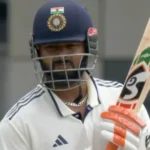India’s AFC Asian Cup Qualifiers Football Match Against Hong Kong in Kowloon: A Penalty Thriller at Kai Tak Stadium
The roar of the crowd still kinda rings in my ears, honestly. Even now, weeks later, I can close my eyes and picture the flashing lights of Kai Tak Stadium, the green of the pitch, and the sheer *tension* hanging in the air. I’ve been around football – really *around* it – for nearly two decades. Not as a player, mind you, but as someone who lives and breathes the game from the sidelines, working with analytics, player performance data, and occasionally, being fortunate enough to be *in* the thick of it, observing firsthand. I’ve seen a lot of games, from local leagues to a few high-profile international clashes, but the India versus Hong Kong qualifier for the AFC Asian Cup? That was something special. It wasn’t just a match; it was a rollercoaster of emotions, a tactical battle unfolding in real time, and a serious reminder of just how dramatic football can be. I’m going to break down what I saw, not just the obvious stuff you’d get from a match report, but the nuances, the little things that often get missed, and what it all means for the Indian team moving forward. Consider this an insider’s look, a conversation with someone who tries to understand the game beyond the goals and tackles.
The Buildup & Why This Game Mattered
Let’s be real, qualifying for the AFC Asian Cup isn’t just another box to tick. It’s huge for Indian football. It’s about showcasing our progress on the continental stage, giving our players valuable experience against top Asian nations, and building a fanbase that truly believes we can compete. For years, Indian football has been labelled as “potential,” always on the cusp of something great, but rarely delivering consistently. Qualifying consistently – and *performing* well at the Asian Cup – is how we shake that label. It’s how we attract more investment, better players, and a higher level of professionalism across the board.
Hong Kong, though, weren’t going to make it easy. They’re a compact, organized team, known for their defensive solidity and ability to frustrate opponents. They’re not a glamorous side, but they’re incredibly effective at what they do. They play a very disciplined game, and they’re difficult to break down. They don’t give you much space, and they make you earn every single yard. Before the match, the talk amongst the analysts (and believe me, there were a LOT of us there) centered around India’s ability to overcome that defensive block. Could we find creative solutions in the final third? Would our midfielders be able to dictate the tempo and unlock their defense? And crucially, could we handle the pressure of playing away from home in a hostile environment?
I’d spent the week leading up to the game pouring over data on Hong Kong’s past performances, looking at their formations, key players, and set-piece routines. Their coach, Jorn Andersen, is a shrewd tactician, and I knew he’d have a plan specifically designed to counter India’s strengths. He favors a 4-4-2 formation, prioritizing defensive stability and looking to hit teams on the counter. Knowing this, I suspected India’s wingers – Sunil Chhetri and the other attacking players – would be key to stretching the play and creating opportunities.
First Half: A Frustrating Stalemate
The first 45 minutes were…well, frustrating. For anyone watching, it probably felt like a classic game of attack versus defense. India had the lion’s share of possession, patiently building from the back, trying to find openings. But Hong Kong were incredibly disciplined. Their two banks of four were almost impenetrable. Every time India tried to play through the middle, they were met with a wall of bodies.
What struck me most wasn’t just *that* they were defending well, but *how* they were defending. They weren’t just relying on athleticism or tackling; they were actively denying space. They were constantly shifting and adjusting their positions, making it incredibly difficult for India’s players to find pockets of space between the lines. Every pass had to be perfect, every run timed to perfection. A slight hesitation, a misplaced pass, and Hong Kong would be straight onto it, snuffing out the attack.
Sunil Chhetri, as always, was trying to make things happen. He was dropping deep to pick up the ball, attempting to link up with the midfielders, and making intelligent runs in behind the defense. But he was often double-teamed, and Hong Kong’s defenders weren’t giving him an inch of space.
India’s midfield, led by Anirudh Thapa, was trying to control the game, but they struggled to find a consistent rhythm. Hong Kong’s midfield was very physical, pressing Thapa and his teammates relentlessly, disrupting their passing lanes and forcing them into rushed decisions. They weren’t afraid to get stuck in, and a few cynical fouls went unpunished, which did little to ease the tension.
The lack of a genuine goal threat from open play was concerning. We saw a few half-chances, crosses into the box that were easily dealt with by the Hong Kong defenders, and a couple of shots from distance that didn’t trouble the goalkeeper. It felt like India was lacking that moment of spark, that bit of magic that could unlock the defense. I was observing the body language of the Indian players, and you could see the frustration building. They were trying, but they were hitting a brick wall.
The analytics confirmed what my eyes were telling me. Passing accuracy in the final third was down, key passes were limited, and the expected goals (xG) metric – a statistical measure of the quality of chances created – was low. We needed a change, a different approach, something to disrupt Hong Kong’s rhythm.
Second Half: Increased Intensity & the Penalty Drama
The second half started with a noticeable increase in intensity from India. The coaching staff clearly had a word during the break. We saw more direct running, more willingness to take risks, and a greater emphasis on getting crosses into the box.
One of the key changes was the introduction of Liston Colaco. He brought a fresh pair of legs and a bit of unpredictability to the attack. He’s a player who likes to run at defenders, and he was immediately causing problems for the Hong Kong fullback. His pace and dribbling ability were forcing them to think twice, and he managed to win a couple of free kicks in dangerous areas.
The game started to open up a little, with both teams creating a few more chances. Hong Kong, sensing India’s increased attacking intent, were starting to look more dangerous on the counter. Their forwards were making runs in behind the defense, and their midfielders were starting to find a bit more space.
Then came the turning point – the penalty. It was a controversial one, to say the least. A challenge in the box, a scramble for the ball, and the referee pointed to the spot. There was a lot of debate amongst the spectators and the analysts about whether it was a clear penalty, but the decision stood. And up stepped Sunil Chhetri…
You could feel the entire stadium hold its breath. Chhetri, a proven goalscorer, a national icon, a man who’s carried the burden of Indian football on his shoulders for years. He calmly stepped up and slotted the ball into the back of the net. 1-0 to India!
But the drama wasn’t over. Hong Kong responded almost immediately. A quick counterattack, a clever through ball, and their striker found himself one-on-one with the goalkeeper. He coolly chipped the ball over the keeper to equalize. 1-1. The stadium erupted.
The last 20 minutes were incredibly tense. Both teams were throwing everything they had at each other. India was desperate to regain the lead, while Hong Kong was content to hold on for a draw and take the game to a penalty shootout. I saw Igor Stimac, the India coach, frantically gesturing to his players, urging them to push forward, to take more risks.
Penalty Shootout: Heartbreak and Lessons Learned
And that’s what happened. The game went to penalties.
Penalties are a lottery, pure and simple. It’s about composure, technique, and a little bit of luck. And unfortunately, on this occasion, luck wasn’t on India’s side.
The shootout was a heartbreaking affair. Both goalkeepers made some good saves, and the tension was almost unbearable. But ultimately, it was Hong Kong who prevailed, winning the shootout 4-3.
Watching from the sidelines, you could see the devastation on the faces of the Indian players. They had given everything, fought hard for 120 minutes, but it wasn’t enough. It was a tough pill to swallow.
But even in defeat, there were lessons to be learned.
Analyzing the Performance: What Went Wrong, and What Went Right
Looking back at the game with a more analytical eye, here’s what I took away:
* **Breaking Down Defenses:** India struggled to break down Hong Kong’s organized defense. We need to develop more creative solutions in the final third, more willingness to try different passing combinations, and more players who are comfortable taking on defenders one-on-one. Relying solely on crosses isn’t enough against a team that’s so dominant in the air. We need to work on our build-up play, our movement off the ball, and our ability to create space.
* **Midfield Control:** While Thapa did his best, India’s midfield didn’t consistently control the tempo of the game. We need a more dynamic midfield pairing, players who can both win the ball back and dictate play. Someone who can consistently pick out a killer pass, or drive forward with the ball.
* **Set-Piece Vulnerability:** Hong Kong’s goal from open play came from a quick counter, but their organized set-piece defending generally nullified India’s chances. We need to refine our set-piece routines both offensively and defensively. Set pieces are often the difference between winning and losing in tight matches, and we need to be more clinical in both boxes.
* **Penalty Shootout Preparation:** Penalty shootouts are part and parcel of modern football. Teams need to practice them regularly, both physically and mentally. Players need to be comfortable taking penalties under pressure, and goalkeepers need to be prepared to make saves. It’s about building confidence and developing a clear strategy.
* **Chhetri’s Continued Importance:** Sunil Chhetri is still a crucial player for India. His experience, leadership, and goalscoring ability are invaluable. But we need to start building a team that doesn’t rely solely on him. We need to develop other players who can step up and take on the responsibility of scoring goals.
* **Hong Kong’s Tactical Acumen:** Give credit where it’s due. Hong Kong were excellent. Their coach, Jorn Andersen, clearly did his homework and devised a game plan that almost worked to perfection. They were disciplined, organized, and physically fit. Their ability to frustrate India and capitalize on their chances was impressive.
Beyond these points, I observed something about the team’s collective mindset. There was a hesitation at key moments, a slight lack of belief. That’s something that comes with experience, with consistently winning games, and with building a winning culture. This Indian team is talented, no question, but it still lacks that killer instinct, that unwavering confidence that separates good teams from great teams.
The Road Ahead: What’s Next for the Blue Tigers?
This defeat was undoubtedly a setback, but it’s not the end of the road. India still has opportunities to qualify for the AFC Asian Cup. And more importantly, it’s a chance to learn and grow.
I think Igor Stimac needs to focus on a few key areas in the coming months.
First, he needs to experiment with different formations and personnel. We need to find a system that gets the best out of our attacking players and allows us to control the midfield. Perhaps a 3-5-2 formation could provide more attacking width and allow us to overload the midfield.
Second, he needs to work on improving the team’s tactical flexibility. We need to be able to adapt to different opponents and situations, and we need to be able to change our game plan on the fly.
Third, he needs to foster a stronger winning mentality. This means building confidence, encouraging risk-taking, and instilling a belief that we can compete with the best teams in Asia. That involves sports psychology, team building exercises, and consistent positive reinforcement.
Finally, and this is truly key, we need to invest in youth development. We need to identify and nurture young talent, and give them opportunities to play at the highest level. The future of Indian football depends on it.
I saw glimpses of promise in some of the younger players who came on during the game. Players with pace, skill, and a willingness to learn. We need to build around these players and give them the support they need to reach their full potential.
Final Thoughts: A Game to Remember (and Learn From)
The India versus Hong Kong qualifier was a match that I won’t soon forget. It was a thrilling, dramatic, and ultimately heartbreaking encounter. It exposed some of our weaknesses, but it also highlighted our potential.
It reminded me that football is a game of inches, a game of fine margins. A single penalty, a single mistake, can be the difference between success and failure. But it also reminded me that football is a game of passion, a game of drama, and a game that can captivate millions of people around the world.
The journey to the AFC Asian Cup is far from over. There will be challenges ahead, setbacks along the way. But with hard work, dedication, and a bit of luck, I believe that India can still achieve its goals. The Blue Tigers have the talent, the potential, and the support of a passionate fanbase. Now, it’s time to turn that potential into reality. And I, for one, will be watching with bated breath, analyzing every pass, every tackle, and every moment of magic. Because that’s what I do— it’s what I love. And it’s a privilege to witness the evolution of Indian football firsthand.
Resources & Further Reading (for the truly dedicated)
* **AFC Asian Cup Official Website:** [https://www.the-afc.com/asiancup](https://www.the-afc.com/asiancup) – For official tournament information and schedules.
* **AIFF (All India Football Federation):** [https://www.the-aiff.com/](https://www.the-aiff.com/) – Official news and updates on the Indian national team.
* **StatsBomb:** [https://statsbomb.com/](https://statsbomb.com/) – Cutting-edge football analytics platform (may require subscription). Provides in-depth data on player performance and team tactics.
* **Wyscout:** [https://wyscout.com/](https://wyscout.com/) – Another leading football analytics platform (also typically requires a subscription).
* **Understat:**[https://understat.com/](https://understat.com/) – A website focused on xG (Expected Goals) data and other advanced football statistics. A free resource for in-depth analysis.
* **The Asian Game:** [https://theasiangame.com/football/afc-asian-cup-qualifiers/](https://theasiangame.com/football/afc-asian-cup-qualifiers/) – News and analysis specifically about Asian football.
I hope this in-depth look into the game was helpful and insightful. Feel free to share your thoughts in the comments below – I always enjoy hearing different perspectives. The beautiful game is always better when discussed!
Anurag Dhole is a seasoned journalist and content writer with a passion for delivering timely, accurate, and engaging stories. With over 8 years of experience in digital media, she covers a wide range of topics—from breaking news and politics to business insights and cultural trends. Jane's writing style blends clarity with depth, aiming to inform and inspire readers in a fast-paced media landscape. When she’s not chasing stories, she’s likely reading investigative features or exploring local cafés for her next writing spot.






